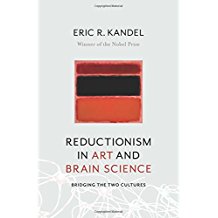Reductionism in Art and Brain Science: Bridging the Two Cultures, Eric Kandel, 2016
Kandel, a Nobel Prize winner for his work on memory at Columbia, tackles C.P. Snow’s two worlds of science and humanities and attempts to bridge them through the exploration of the science of seeing and the explosive growth of abstract expressionism in the post-WWII period. Not an easy read, but worth the effort as Kandel takes the reader through the brain science of vision, reducing it to its component parts from the translation of the two dimensional image on the retina to the individual beholder’s ‘seeing’ the object in space and time. He teases out the elements of top down and bottom up processing, the ‘what’ and the ‘where’ pathways, and the role of the amygdala (orchestrator of emotion) and the hippocampus (executor of emotion and holder of memory) as the brain adds context and memory to the sensations of light perception to create meaning. He relates the movement towards abstract art as dependent on our move away from bottom up, familiar, and evolutionary seeing towards top down, emotional, spiritual, default pathway seeing that depends on the artists’ reductionism from the figurative to line, shape, form, and color. He cites many artists beginning with Turner, Monet, and Kandinsky and moving into the big four of abstract expressionism: DeKooning, Pollack, Rothko, and Morris Louis. He discusses the work of contemporary artists such as Alex Katz, Agnes Martin, Dan Flavin, James Turrell, Andy Warhol, and Chuck Close. This is a complex and fascinating topic that Kandel discusses in a clear and compelling manner. I will never look at another abstract painting without thinking about the pathway from retina to amygdala!



